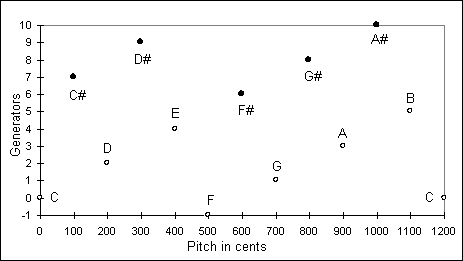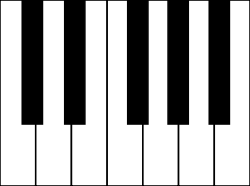
Generalized keyboard
Encyclopedia
Generalized keyboards are musical keyboards with regular, tile-like arrangements usually with rectangular or hexagonal keys, and were developed for performing music in different tunings. They were introduced by Robert Bosanquet in the 1870s, and since the 1960s Erv Wilson
has developed new methods of using and expanding them, proposing keyboard layouts (and some notations) including but not limited to any scale made of a single generator within a "octave"(or more generally, period) of any size.
The generalized keyboard is one kind of symmetrical arrangement that represents pitches according to their relationship to each other - rather than their positions in specific scales such as in the familiar piano and organ keyboard - as well as in sequence of pitch, unlike arrangements such as duet systems for concertinas and the array system keyboard. Bosanquet used chains of fifths
to generate the mapping of the keys, with the pitches transposed into the space of an octave (or more generally, period) so that pitch determined the lateral position of keys, and the number of fifths, or any other interval used as generators, from the starting pitch its vertical position in the keyboard.

 The coordinates of a key can be calculated using the size of the generator (in cents), where the vertical position is the number of generators away from the starting pitch, (positive or negative depending on whether they are in the sharp or flat direction), which Bosanquet rounded to the nearest semitone, giving 12 vertically aligned rows of keys in each octave. Wilson introduced alternate arrangements with combinations of seven or five (and in some cases, i.e. a division of the octave in 13 tones, eight) vertical lines of keys, and so Bosanquet keyboard sometimes is used to distinguish the original arrangement.
The coordinates of a key can be calculated using the size of the generator (in cents), where the vertical position is the number of generators away from the starting pitch, (positive or negative depending on whether they are in the sharp or flat direction), which Bosanquet rounded to the nearest semitone, giving 12 vertically aligned rows of keys in each octave. Wilson introduced alternate arrangements with combinations of seven or five (and in some cases, i.e. a division of the octave in 13 tones, eight) vertical lines of keys, and so Bosanquet keyboard sometimes is used to distinguish the original arrangement.
The angle between keys originally depended on the shape of the key and relative size of the generating fifth, but Bosanquet discovered fingering could sometimes be improved by reversing this angle; the angle can also be straightened out, or the spacing changed to better represent the keys' pitches, which alters vertical alignment. Generalized keyboards usually duplicate pitches mapped close to the front and rear edges of the arrangement in order to organize pitches for consistent fingering. This can result in very large arrangements depending on the shape of the keys and any modifications made to the basic design.
The possibility of the duplication of pitches occurs because the generalized keyboard is, in principle, a mapping of pitches onto a closed space in which intervals and chords have fixed shapes under transposition across the keyboard; thus a generalized keyboard is a useful tool for the analysis of harmonic structures.
Erv Wilson
Ervin Wilson is a Mexican/American music theorist. Despite his avoidance of academia, Wilson has been influential on those interested in microtonal music and just intonation, especially in the areas of scale, keyboard, and notation design...
has developed new methods of using and expanding them, proposing keyboard layouts (and some notations) including but not limited to any scale made of a single generator within a "octave"(or more generally, period) of any size.
The generalized keyboard is one kind of symmetrical arrangement that represents pitches according to their relationship to each other - rather than their positions in specific scales such as in the familiar piano and organ keyboard - as well as in sequence of pitch, unlike arrangements such as duet systems for concertinas and the array system keyboard. Bosanquet used chains of fifths
Circle of fifths
In music theory, the circle of fifths shows the relationships among the 12 tones of the chromatic scale, their corresponding key signatures, and the associated major and minor keys...
to generate the mapping of the keys, with the pitches transposed into the space of an octave (or more generally, period) so that pitch determined the lateral position of keys, and the number of fifths, or any other interval used as generators, from the starting pitch its vertical position in the keyboard.


The angle between keys originally depended on the shape of the key and relative size of the generating fifth, but Bosanquet discovered fingering could sometimes be improved by reversing this angle; the angle can also be straightened out, or the spacing changed to better represent the keys' pitches, which alters vertical alignment. Generalized keyboards usually duplicate pitches mapped close to the front and rear edges of the arrangement in order to organize pitches for consistent fingering. This can result in very large arrangements depending on the shape of the keys and any modifications made to the basic design.
The possibility of the duplication of pitches occurs because the generalized keyboard is, in principle, a mapping of pitches onto a closed space in which intervals and chords have fixed shapes under transposition across the keyboard; thus a generalized keyboard is a useful tool for the analysis of harmonic structures.

